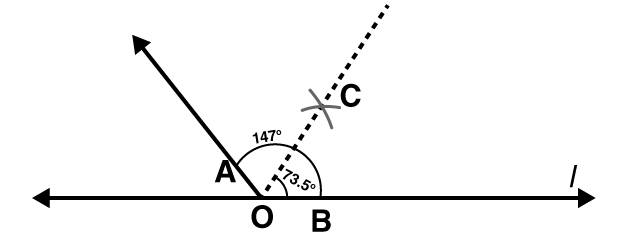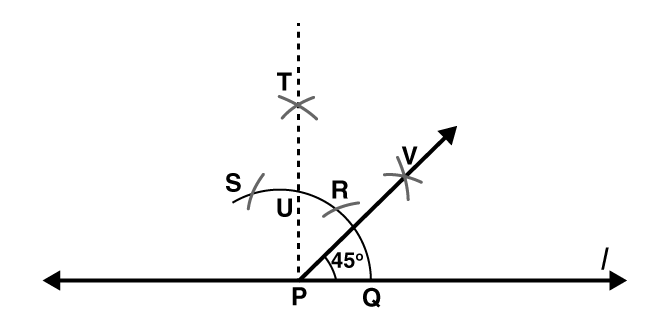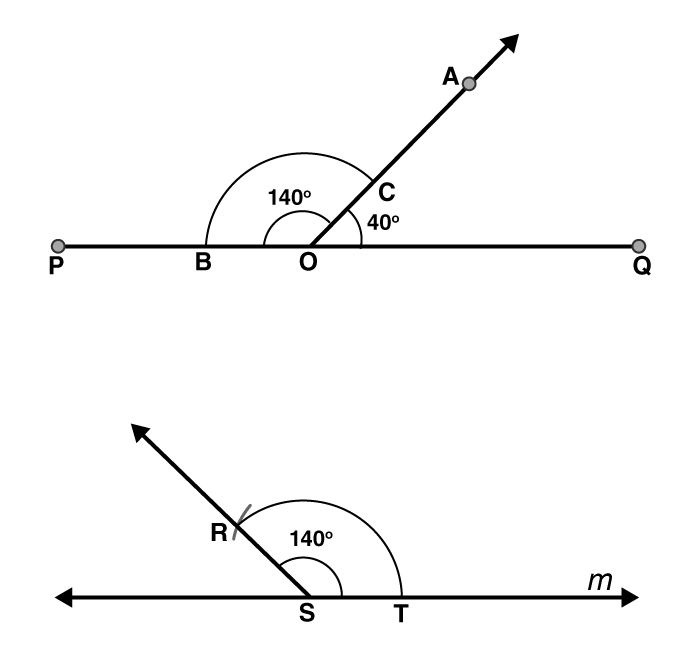NCERT Solutions Class 6 Maths
Chapter – 14 (Practical Geometry)
The NCERT Solutions in English Language for Class 6 Mathematics Chapter – 14 Practical Geometry Exercise 14.6 has been provided here to help the students in solving the questions from this exercise.
Chapter 14: Practical Geometry
- NCERT Solution Class 6 Maths Exercise – 14.1
- NCERT Solution Class 6 Maths Exercise – 14.2
- NCERT Solution Class 6 Maths Exercise – 14.3
- NCERT Solution Class 6 Maths Exercise – 14.4
- NCERT Solution Class 6 Maths Exercise – 14.5
Exercise – 14.6
1. Draw ∠POQ of measure 75° and find its line of symmetry.
Solutions:
 Step 1: Draw a line l and mark two points O and Q on it, as shown in the figure. Draw an arc of convenient radius, while taking point O as centre. Let it intersect line l at R.
Step 1: Draw a line l and mark two points O and Q on it, as shown in the figure. Draw an arc of convenient radius, while taking point O as centre. Let it intersect line l at R.
Step 2: Taking R as centre and with the same radius as before, draw an arc intersecting the previously drawn arc at S.
Step 3: Taking S as centre and with the same radius as before, draw an arc intersecting the arc at T (see figure).
Step 4: Taking S and T as centre, draw an arc of same radius to intersect each other at U.
Step 5: Join OU. Let it intersect the arc at V. Now, taking S and V as centres, draw arcs with radius more than SV. Let those intersect each other at P. Join OP, which is the ray making 75° with the line l.
Step 6: Let this ray be intersecting our major arc at point W. Now, taking R and W as centres, draw arcs with radius more than RW in the interior of angle of 75º. Let these be intersecting each other at X. Join OX.
OX is the line of symmetry for ∠POQ = 75°.
2. Draw an angle of measure 147° and construct its bisector.
Solutions:
Following steps are followed to construct an angle of measure 1470 and its bisector
 Step 1: Draw a line l and mark point O on it. Place the centre of protractor at point O and the zero edge along line l.
Step 1: Draw a line l and mark point O on it. Place the centre of protractor at point O and the zero edge along line l.
Step 2: Mark a point A at an angle of measure 1470. Join OA. Now OA is the required ray making 1470 with line l.
Step 3: By taking point O as centre, draw an arc of convenient radius. Let this intersect both rays of angle 1470 at points A and B.
Step 4: By taking A and B as centres draw arcs of radius more than 1 / 2 AB in the interior angle of 1470. Let these intersect each other at point C. Join OC.
OC is the required bisector of 1470 angle
3. Draw a right angle and construct its bisector.
Solutions:
Following steps are followed to construct a right angle and its bisector.
 Step 1: Draw a line l and mark a point P on it. Draw an arc of convenient radius by taking point P as centre. Let this intersect line l at R.
Step 1: Draw a line l and mark a point P on it. Draw an arc of convenient radius by taking point P as centre. Let this intersect line l at R.
Step 2: Draw an arc by taking R as centre and with the same radius as before such that it is intersecting the previously drawn arc at S.
Step 3: Take S as centre and with the same radius as before, draw an arc intersecting the arc at T as shown in figure
Step 4: By taking S and T as centres draw arcs of same radius such that they are intersecting each other at U.
Step 5: Join PU. PU is the required ray making a right angle with the line l. Let this intersect major arc at point V.
Step 6: Now take R and V as centres, draw arcs with radius more than 1 / 2 RV to intersect each other at point W. Join PW.
PW is the required bisector of this right angle.
4. Draw an angle of measure 153° and divide it into four equal parts.
Solutions:
Following steps are followed to construct an angle of measure 1530 and its bisector
 Step 1: Draw a line l and mark a point O on it. Place the centre of protractor at point O and the zero edge along line l.
Step 1: Draw a line l and mark a point O on it. Place the centre of protractor at point O and the zero edge along line l.
Step 2: Mark a point A at the measure of angle 1530. Join OA. Now OA is the required ray making 1530 with line l.
Step 3: Draw an arc of convenient radius by taking point O as centre. Let this intersect both rays of angle 1530 at points A and B.
Step 4: Take A and B as centres and draw arcs of radius more than AB in the interior of angle of 1530. Let these intersect each other at C. Join OC.
Step 5: Let OC intersect major arc at point D. Draw arcs of radius more than AD with A and D as centres and also D and B as centres. Let these are intersecting each other at points E and F, respectively. Now join OE and OF
OF, OC, OE are the rays dividing 1530 angle into four equal parts.
5. Construct with ruler and compasses, angles of following measures:
(a) 60°
(b) 30°
(c) 90°
(d) 120°
(e) 45°
(f) 135°
Solutions:
(a) 600
Following steps are followed to construct an angle of 600 Step 1: Draw a line l and mark a point P on it. Take P as centre and with convenient radius, draw an arc of a circle such that it intersects the line l at Q.
Step 1: Draw a line l and mark a point P on it. Take P as centre and with convenient radius, draw an arc of a circle such that it intersects the line l at Q.
Step 2: Take Q as centre and with the same radius as before, draw an arc intersecting the previously drawn arc at point R.
Step 3: Join PR. PR is the required ray making 600 with the line l.
(b) 300
Following steps are followed to construct an angle of 300

Step 1: Draw a line l and mark a point P on it. By taking P as centre and with convenient radius, draw an arc of a circle such that it is intersecting the line l at Q.
Step 2: Take Q as centre and with the same radius as before, draw an arc intersecting the previously drawn arc at point R.
Step 3: By taking Q and R as centres and with radius more than RQ draw arcs such that they are intersecting each other at S. Join PS which is the required ray making 300 with the line l.
(c) 900
Following steps are followed to construct an angle of measure 900
 Step 1: Draw a line l and mark a point P on it. Take P as centre and with convenient radius, draw an arc of a circle such that it is intersecting the line l at Q.
Step 1: Draw a line l and mark a point P on it. Take P as centre and with convenient radius, draw an arc of a circle such that it is intersecting the line l at Q.
Step 2: Take Q as centre and with the same radius as before, draw an arc intersecting the previously drawn arc at R.
Step 3: By taking R as centre and with the same radius as before, draw an arc intersecting the arc at S as shown in figure.
Step 4: Now take R and S as centre, draw arc of same radius to intersect each other at T.
Step 5: Join PT, which is the required ray making 900 with the line l.
(d) 1200
Following steps are followed to construct an angle of measure 1200
 Step 1: Draw a line l and mark a point P on it. Taking P as centre and with convenient radius, draw an arc of circle such that it is intersecting the line l at Q.
Step 1: Draw a line l and mark a point P on it. Taking P as centre and with convenient radius, draw an arc of circle such that it is intersecting the line l at Q.
Step 2: By taking Q as centre and with the same radius as before, draw an arc intersecting the previously drawn arc at R.
Step 3: Take R as centre and with the same radius as before, draw an arc such that it is intersecting the arc at S as shown in figure.
Step 4: Join PS, which is the required ray making 1200 with the line l
(e) 450
Following steps are followed to construct an angle of measure 450
 Step 1: Draw a line l and mark a point P on it. Take P as centre and with convenient radius, draw an arc of a circle such that it is intersecting the line l at Q.
Step 1: Draw a line l and mark a point P on it. Take P as centre and with convenient radius, draw an arc of a circle such that it is intersecting the line l at Q.
Step 2: Take Q as centre and with the same radius as before, draw an arc intersecting the previously drawn arc at R.
Step 3: By taking R as centre and with the same radius as before, draw an arc such that it is intersecting the arc at S as shown in figure.
Step 4: Take R and S as centres and draw arcs of same radius such that they are intersecting each other at T.
Step 5: Join PT. Let this intersect the major arc at point U.
Step 6: Now take Q and U as centres and draw arcs with radius more than QU to intersect each other at point V. Join PV.
PV is the required ray making 450 with the line l
(f) 1350
Following steps are followed to construct an angle of measure 1350
 Step 1: Draw a line l and mark a point P on it. Taking P as centre and with convenient radius, draw a semicircle which intersects the line l at Q and R, respectively.
Step 1: Draw a line l and mark a point P on it. Taking P as centre and with convenient radius, draw a semicircle which intersects the line l at Q and R, respectively.
Step 2: By taking R as centre and with the same radius as before, draw an arc intersecting the previously drawn arc at S.
Step 3: Taking S as centre and with the same radius as before, draw an arc such that it is intersecting the arc at T as shown in figure.
Step 4: Take S and T as centres, draw arcs of same radius to intersect each other at U.
Step 5: Join PU. Let this intersect the arc at V. Now take Q and V as centres and with radius more than QV, draw arcs to intersect each other at W.
Step 6: Join PW which is the required ray making 1350 with the line l
6. Draw an angle of measure 45° and bisect it.
Solutions:
Following steps are followed to construct an angle of measure 450 and its bisector.
 Step 1: Using the protractor ∠POQ of 450 measure may be formed on a line l.
Step 1: Using the protractor ∠POQ of 450 measure may be formed on a line l.
Step 2: Draw an arc of convenient radius with centre as O. Let this intersect both rays of angle 450 at points A and B.
Step 3: Take A and B as centres, draw arcs of radius more than 1 / 2 AB in the interior of angle of 450. Let these intersect each other at C. Join OC
OC is the required bisector of 450 angle
7. Draw an angle of measure 135° and bisect it.
Solutions:
Following steps are followed to construct an angle of measure 1350 and its bisector.
 Step 1: By using a protractor ∠POQ of 1350 measure may be formed on a line l.
Step 1: By using a protractor ∠POQ of 1350 measure may be formed on a line l.
Step 2: Draw an arc of convenient radius by taking O as centre. Let this intersect both rays of angle 1350 at points A and B, respectively.
Step 3: Take A and B as centres, draw arcs of radius more than 1 / 2 AB in the interior of angle of 1350. Let these intersect each other at C. Join OC.
OC is the required bisector of 1350 angle
8. Draw an angle of 700. Make a copy of it using only a straight edge and compasses.
Solutions:
Following steps are followed to construct an angle of measure 700 and its copy.
 Step 1: Draw a line l and mark a point O on it. Now place the centre of protractor at point O and the zero edge along line l.
Step 1: Draw a line l and mark a point O on it. Now place the centre of protractor at point O and the zero edge along line l.
Step 2: Mark a point A at an angle of measure 700. Join OA. Now OA is the ray making 700 with line l. With point O as centre, draw an arc of convenient radius in the interior of 700 angle. Let this intersect both rays of angle 700 at points B and C, respectively
Step 3: Draw a line m and mark a point P on it. Again draw an arc with same radius as before and P as centre. Let it cut the line m at point D.
Step 4: Adjust the compasses up to the length of BC. With this radius draw an arc taking D as centre which intersects the previously drawn arc at point E.
Step 5: Join PE. Here PE is the required ray which makes same angle of measure 700 with the line m
9. Draw an angle of 400. Copy its supplementary angle.
Solutions:
Following steps are followed to construct an angle of measure 450 and a copy of its supplementary angle

Step 1: Draw a line segment and mark a point O on it. Place the centre of protractor at point O and the zero edge along line segment
.
Step 2: Mark a point A at an angle of measure 400. Join OA. Here OA is the required ray making 400 with . ∠POA is the supplementary angle of 400.
Step 3: With point O as centre, draw an arc of convenient radius in the interior of ∠POA. Let this intersect both rays of ∠POA at points B and C, respectively.
Step 4: Draw a line m and mark a point S on it. Again draw an arc by taking S as centre with the same radius as used before. Let it cut the line m at point T.
Step 5: Now adjust the compasses up to the length of BC. Taking T as centre draw an arc with this radius which will intersect the previously drawn arc at point R.
Step 6: Join RS. Here RS is the required ray which makes same angle with the line m, as the supplementary of 400 [i.e 1400]

